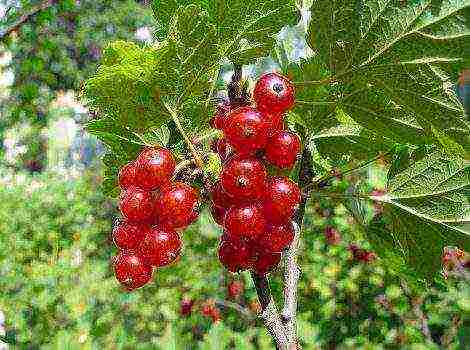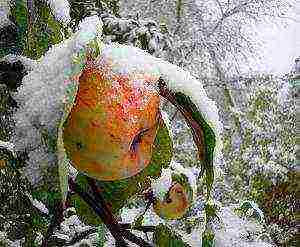Content
- 1 1. Bobo
- 2 2. Vanille Fraise
- 3 3. Wim's Red
- 4 4. Grandiflora
- 5 5. Diamand Rouge
- 6 6. Kyushu
- 7 7. Limelight
- 8 8. Little Lime
- 9 9. Magical Candle
- 10 10. Pink Diamond
- 11 11. Pinky Winky
- 12 12. Sundae Fraise
- 13 13. Silver Dollar
- 14 14. Phantom
- 15 15. Fraise Melba
- 16 The best varieties of panicle hydrangeas
- 17 The best varieties of tree hydrangeas
- 18 The best varieties of large-leaved hydrangeas
- 19 Description
- 20 Panicle hydrangea: varieties, photos
- 21 The most popular and beautiful varieties for the Moscow region
- 22 Description and characteristics, features of panicle hydrangea
- 23 Planting tips
- 24 Good care after planting
- 25 The use of pink, yellow and other hydrangeas in landscape design
Not sure which flower to plant on your site? Pay attention to the best varieties of hydrangea paniculata. These luxurious plants will leave no one indifferent.
Hydrangea paniculata differs from the equally popular tree-like inflorescence mainly in the form of inflorescences: they resemble a wide pyramid. Inflorescences usually consist of small (bisexual) and large (sterile) flowers. Moreover, during flowering, they gradually change their color.
1. Bobo
Dwarf variety Bobo in 2011 at a flower show in Belgium received the award "Best variety". During the abundant and prolonged flowering of this hydrangea, the color of its petals changes from white-yellow to pale pink.
Due to its low growth, the Bobo hydrangea is suitable for growing in containers that can be placed on the balcony or summer terrace. It is desirable that this be a semi-shaded place, since in the bright sun the hydrangea inflorescences become smaller. At the same time, it is important that the shrubbery is protected from gusty winds.
|
Appointment |
Bush height (cm) |
Bush width (cm) |
Flowering period |
Peculiarities |
|
July to September |
Plant winter hardy, but the roots young bushes for the winter you need mulch. |
|||
2. Vanille Fraise
This variety is suitable only for a large flower garden: in a short time, the shrub can reach a height of 2 m.Large inflorescences (about 30 cm in diameter), similar to clusters of lilacs, amaze with their unusual color: the petals can be snow-white and rich crimson at the same time.
Hydrangea Vanilla Fries looks best in mixborders, where it is combined with phlox, stonecrop, highlander, cuff and large varieties of hosts.
|
Appointment |
Bush height (cm) |
Bush width (cm) |
Flowering period |
Peculiarities |
|
July to September |
Withstands downgrade temperature up to -40 ° С, fast recovering, even will freeze. |
|||
3. Wim's Red
The flowers of this hydrangea are collected in conical inflorescences about 35 cm long, which exude a pleasant honey aroma. From the beginning of summer until the very frost, the inflorescences gradually change color: the newly blossoming petals are white, over time they turn pink, and in the fall they become deep red.
|
Appointment |
Bush height (cm) |
Bush width (cm) |
Flowering period |
Peculiarities |
|
June to October |
Prefers bright light, but can grow and in partial shade. On acidic soils flower coloring more intense. Does not need in a winter shelter. |
|||
4. Grandiflora
The flowers of the Grandiflora hydrangea are collected in huge pyramidal panicle inflorescences. When blooming, they are creamy white, in full bloom they are snow-white, by the end of summer they become pinkish, and in autumn they are greenish-red.
|
Appointment |
Bush height (cm) |
Bush width (cm) |
Flowering period |
Peculiarities |
|
From mid-June to October |
Prefers penumbra. Grows well in urban conditions, but at securing abundant watering. In young plants for the winter recommended harbor near-trunk circle. |
|||
5. Diamand Rouge
This erect shrub has a fairly compact shape.On it there are large inflorescences (up to 40 cm long), first white, and then incredibly rich crimson-red color. No other panicle hydrangea has such a bright shade!
The leaves of the Diamond Rouge hydrangea look no less impressive: in spring and summer they are green, and in autumn they turn orange.
|
Appointment |
Bush height (cm) |
Bush width (cm) |
Flowering period |
Peculiarities |
|
From the end of June to September |
Hydrangea stable to urban conditions and frost, does not need in the shelter. Poorly tolerates drought. |
|||
6. Kyushu
This tall shrub with a rounded dense crown and wide-pyramidal panicle inflorescences (up to 25 cm long) is grown in city parks and in personal plots. The Kyushu hydrangea flowers are white and very fragrant. A distinctive feature of this variety of hydrangeas is glossy dark green leaves located on red petioles, which turn yellowish in autumn.
|
Appointment |
Bush height (cm) |
Bush width (cm) |
Flowering period |
Peculiarities |
|
From mid-June until mid-September |
Growing fast frost hardy (up to -25 ° С), demanding on fertility and soil moisture. Attractive for insects. |
|||
7. Limelight
This plant has gained popularity among landscape designers due to its very strong shoots, which, without stands and supports, can perfectly withstand heavy inflorescences.
Large inflorescences-panicles at the beginning of flowering in the shade are greenish (lime-colored - hence the name of the variety), and in the sun - pure white. At the end of flowering, they turn pink. Limelight hydrangea has slightly velvety leaves. In summer they are green, and in autumn they take on a purple hue.
|
Appointment |
Bush height (cm) |
Bush width (cm) |
Flowering period |
Peculiarities |
|
From the end of July to September |
Hydrangea photophilous and hygrophilous. Young plants need shelter for the winter, with age winter hardiness rises. |
|||
8. Little Lime
This short shrub resembles a Limelight hydrangea with its inflorescences: at first they are whitish-pistachio (in the open sun - light green), and by the end of flowering they become slightly pinkish. However, these two varieties mainly differ only in the size of the bush.
|
Appointment |
Bush height (cm) |
Bush width (cm) |
Flowering period |
Peculiarities |
|
July to October |
Plant well hibernates without shelter, prefers wet, drained and fertile soil, transfers stagnant water. |
|||
9. Magical Candle
This plant is characterized by a spreading crown, elongated, slightly toothed leaves and large pyramidal inflorescences that exude a pleasant aroma. When blooming, the flowers are white-cream (sometimes slightly greenish), then gradually acquire a pink tint, and in autumn they become crimson.
|
Appointment |
Bush height (cm) |
Bush width (cm) |
Flowering period |
Peculiarities |
|
From mid-June to September |
Prefers penumbra and acidic soil. Tolerates well pruning and not afraid of frost. |
|||
10. Pink Diamond
On a rather tall erect bush among light green rough leaves, large panicle inflorescences bloom. At first, the flowers are white, then gradually turn pink and by autumn they become red-crimson.
|
Appointment |
Bush height (cm) |
Bush width (cm) |
Flowering period |
Peculiarities |
|
From the end of July until early October |
In early spring needs in pruning. Plant winter hardy, but in a young his age need shelter. |
|||
11. Pinky Winky
This variety was bred more than 10 years ago, but to this day it does not leave the list of the best varieties of panicle hydrangea. A shrub or small tree with a broadly rounded crown every year adds 30 cm in growth. On its powerful stems there are panicle inflorescences, which are white at the beginning of flowering, and by autumn they acquire a pink-purple hue.
Pinky Winky's hydrangea leaves are no less attractive: in summer they are green, slightly rough, and in autumn they turn purple-red.
|
Appointment |
Bush height (cm) |
Bush width (cm) |
Flowering period |
Peculiarities |
|
From the end of June to September |
Mature bushes withstand frosts down to -25 ° С, and young in winter may freeze, therefore need in shelter burlap or spruce branches. |
|||
12.Sunday Fraise
The bush of this hydrangea is very compact, dense and even. Shoots are red-brown. The leaves are pubescent, especially along the veins. The flowers are white at first, and by the end of summer they become lilac-pink.
|
Appointment |
Bush height (cm) |
Bush width (cm) |
Flowering period |
Peculiarities |
|
From mid-June until October |
The plant is resistant to disease and pests not afraid of frost. Prefers fertile soil, best of all grows in partial shade. |
|||
13. Silver Dollar
This tall shrub got its name from its unusual inflorescences: at the beginning of flowering, they are white with a greenish tint, and by autumn they become silvery pink. Emerald green ovoid leaves are also attractive.
|
Appointment |
Bush height (cm) |
Bush width (cm) |
Flowering period |
Peculiarities |
|
July to September |
Withstands frosts down to -29 ° С, but in the first year for the winter root plant system need to protect using mulch. Thanks to strong shoots plant does not require garters. |
|||
14. Phantom
The variety is highly regarded for its lush flowering and unique honey aroma, which exude beautiful flowers. In summer, the inflorescences are light cream, and by autumn they become pinkish, while their tops turn yellow. The petals of this plant are slightly different from other hydrangeas: they are slightly elongated and not so close to each other.
|
Appointment |
Bush height (cm) |
Bush width (cm) |
Flowering period |
Peculiarities |
|
July to September |
In the middle lane young plants can freeze, therefore their harbor a layer of mulch. |
|||
15. Fraise Melba
For the first time the variety was presented in June 2014 at the exhibition "Gardens and People" in Russia. Due to its unpretentious cultivation and lush flowering, this hydrangea quickly gained popularity.
This shrub with a spreading crown, vertical shoots and unusual pointed foliage of a dark green color, compared to other hydrangeas, grows rather slowly, but with good care in adulthood, it can reach 2 m.
The overflow in the color of the inflorescences looks very impressive in the hydrangea Fries Melba. At first they are milky white, then they acquire pale pink tones, and by the end of flowering they become wine red. At the same time, flowers of 3 different shades often bloom in one inflorescence.
|
Appointment |
Bush height (cm) |
Bush width (cm) |
Flowering period |
Peculiarities |
|
July to September |
Plant branches very dense therefore do not require garters. To inflorescences were large annually in spring should be carried out short cut. |
|||
What wonderful panicle hydrangeas decorate your flower garden?
Review of the best paniculate, tree-like and large-leaved hydrangeas according to the reviews of florists
Hydrangea is a lush and long-flowering deciduous shrub. The thyroid inflorescences consist of fertile (bisexual) and sterile (sterile) flowers. They can be chaotically located, but more often they form viburnum-shaped inflorescences with fertile flowers in the center and sterile along the edge. There are varieties with only one type of flower. The scutellum can be flat, spherical, hemispherical, or pyramidal. Treelike and panicle hydrangeas have taken root well in Central Russia, largely due to their vitality. In the Moscow region, hydrangeas grow best in the open sun; in the southern regions of Russia, it is recommended to plant them in partial shade. In care, it is important to ensure regular and abundant watering (it is not for nothing that the Latin name for hydrangea hydrangea is translated as "a vessel with water"). We will tell you in detail about the best varieties of hydrangeas in our review.
In Russia, varieties of 3 types of hydrangea are widespread: tree, paniculate and large-leaved.
Hydrangea paniculata (Hydrangea paniculata). Shrub or standard tree 2 - 5 m high. Wild forms are found in Japan and China. Panicle hydrangea Differs in dark green leaves and burgundy shoots. Inflorescences are formed on the shoots of the current year. The buds bloom very slowly, so abundant mass flowering occurs in August. The inflorescence is a pyramidal scutellum, reminiscent of a panicle. At the time of dissolution, a greenish tint is present, then the color becomes pure white or cream, and by autumn pinkish tones with a brick tint and again a greenish tint appear. The flowering bush attracts bees with its aroma and is a good honey plant. The high frost resistance of the species makes it possible to grow it even in the North-West region. In the Moscow region, panicle hydrangeas winter without shelter. Shoots woody quickly and winter well.
Hydrangea (Hydrangea arborescens). Shrub from 1 to 3 m in height, native to North America. Unpretentious and winter hardy. Loves shading. Able to endure short-term drought: drooping leaves "come to life" immediately after abundant watering. Spherical or flat shields are formed at the tops of annual shoots. At the beginning of flowering, the inflorescences have a greenish tint, and in full dissolution they become creamy. In the inflorescences, fertile flowers predominate, and there are few sterile ones. But there are varieties with sterile inflorescences. Shields are large, with a diameter of 10 - 15 to 20 cm. It blooms from June to September. Young growth often does not ripen and freezes out, but after spring pruning, the bush grows back well. Freezing does not affect flowering.
Large-leaved hydrangea (Hydrangea macrophylla). Shrub 1 - 2 m high. In winter it leaves with green herbaceous shoots, which will become lignified only the next year. This biological feature leads to strong freezing of young growth in a harsh climate. In winter, all leaves are removed, the shoots are tied, bent to the ground and covered with lutrasil. Inflorescences are not formed on all annual shoots, so the flowering is not as abundant, unlike other types of hydrangea. Inflorescences exceed 20 cm in diameter. Dwarf varieties are good for container growing. The shape and color of the inflorescences is varied. Varieties of the "changeable" variety are able to change the color of the inflorescences depending on the chemical composition of the soil. Large-leaved hydrangeas grow best in acidic soils.
Rating of the best varieties of hydrangeas - TOP 10
The best varieties of panicle hydrangeas
|
Polar Bear 480 (for a seedling with a height of 30 - 40 cm with a closed root system) The Polar Bear variety opens our rating of the best panicle hydrangeas. The variety appeared as a result of crossing the panicle hydrangeas Limelight and Grandiflora. The variety has surpassed its parents. The shrub is 1.5 - 2 m high, very compact and tidy. Inflorescences are dense, broadly pyramidal, up to 30 - 40 cm long. Large clusters are formed on strong shoots that do not droop and retain the shape of the crown. The flowers are predominantly sterile, very large, more than 3 cm in diameter. Huge airy snow-white inflorescences fully justify the name "Polar Bear". At the beginning of the dissolution, the flowers have a delicate pistachio color, which is replaced by white and cream, at the end of summer they turn pink. On one bush, white and pink inflorescences from the base may be present at the same time. It adapts well to growing conditions, is resistant to increased gas pollution, and is rarely affected by diseases. Easy to form and recover quickly. It hibernates without shelter, but in the Moscow region and the Middle Lane, trunk circles are mulched with sawdust or needles. Main pluses:
Minuses:
|
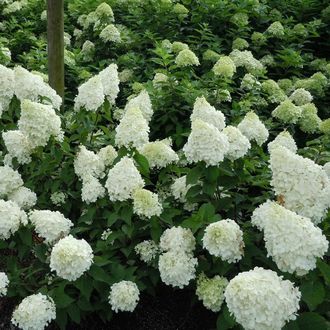 9.9 / 10 Rating Reviews I discovered hydrangeas from the Polar Bear variety.Now I grow several varieties, but I still consider the Polar Bear panicle hydrangea to be the best and most beautiful.
|
|
Phantom 450 (for a seedling with a height of 30 - 40 cm with a closed root system) A powerful, fast-growing, spreading bush, often exceeding 2 meters in height, up to 2 m wide. Shoots are strong, upright. The young growth is juicy red-brown in color, and the old shoots take on a grayish tint. Inflorescences are broadly conical with a blunt apex, more than 30 cm long, consists of large sterile flowers. In September, the creamy color changes to pale pink. Able to grow on any soil. Differs in high resistance to diseases. Even when planted on waterlogged soils, the bushes do not suffer from root rot. Shows excellent winter hardiness, and during freezing in some years it quickly recovers and blooms luxuriantly. The variety is perfect both for bush formation and for growing a standard tree. It is able to grow in one place for several decades without transplantation and rejuvenation. It propagates well by cuttings and layering. In the middle lane, it is preferable to plant in sunny areas. Main pluses:
Minuses:
|
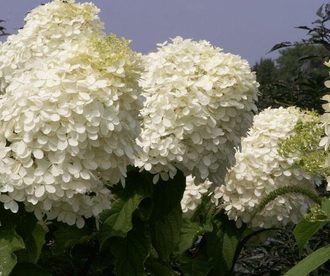 9.8 / 10 Rating Reviews On my site, the soil is far from ideal for hydrangeas, but the Phantom feels great, blooms with wide brushes of 25 cm long.
|
|
Vanilla Fraise 400 (for a seedling with a height of 30 - 40 cm with a closed root system) Vanille Fraise is a variety of panicle hydrangea that is very popular among gardeners. Shrub 1.5 - 2 m high, with an asymmetric wide spreading crown. This variety got the name "vanilla strawberry" for the unique color of the inflorescences. At the beginning of flowering, they are pale white, but in the sun, over time, the flowers begin to turn pink from the base, acquiring a crimson color by autumn. As a result, the individual inflorescence looks like whipped vanilla ice cream with strawberry syrup. The length of the broad-pyramidal inflorescences is 30 - 35 cm. The flowers are sterile. The shoots droop under the weight of the inflorescences. The plant is unpretentious and frost-resistant (4 - 5 zone). In the Moscow region, adult bushes hibernate without shelter, but mulching is carried out for young seedlings. Blooms in the first year of planting. Main pluses:
Minuses:
|
 9.7 / 10 Rating Reviews I think this panicle hydrangea is the best for the Moscow region - unlike other varieties, Vanilla Freyz turns pink earlier and looks gorgeous.
|
|
Pinky Winky 400 (for a seedling with a height of 30 - 40 cm with a closed root system) Spectacular Belgian variety of panicle hydrangea. The bush in different regions has a height of 1.5 - 2.5 m. The crown of an adult plant is wide, spreading. Shoots not drooping, red-brown, standing out among the sparse leaves. White cone-shaped inflorescences with a pointed apex consist of fertile and sterile flowers, the latter prevailing. A feature of the variety is the continued growth of inflorescences in the fall. As a result, the bases turn bright purple, and new large white flowers bloom at the top. Inflorescences of medium density, directed upwards. With good care, the inflorescences already in the first flowering will be large, 20 - 25 cm long. Young bushes can not be tied up, but with age, the appearance of especially large panicles in rainy and windy weather can lead to bending of the shoots, therefore, a garter is used to support. Winter hardiness is high. Before winter, it is recommended to cut off the inflorescences to eliminate the likelihood of shoots breaking off. In some years, preventive treatments may be required. Main pluses:
Minuses:
|
 9.5 / 10 Rating Reviews I planted a seedling in a sunny place, I indulge in top dressing and rejoice at the beautiful inflorescences. Pinky Winky is a very good variety of panicle hydrangea, with proper care it will certainly thank you.
|
|
Limelight 400 (for a seedling 20-30 cm high with a closed root system) A powerful, compact bush with a height of 2 m, does not fall apart under the weight of inflorescences and does not require a garter. Shoots are green, densely leafy. Shirokopyramidalnye sterile inflorescences up to 30 cm long appear in August and decorate the bush until October. At the beginning of flowering, the flowers have a bright lime shade, which becomes yellow-green in partial shade, and snow-white in the sun. By the fall, a typical pinkish hue appears. In autumn, lilac leaves increase the decorative effect. Maintaining soil fertility is important to obtain large, greenish buds. In winter, it is recommended to cut off all inflorescences so that the shoots do not break under the weight of snow-covered brushes. Shows good resistance to disease and frost. Young bushes in a harsh winter can freeze slightly, but with age, frost resistance increases. Main pluses:
Minuses:
|
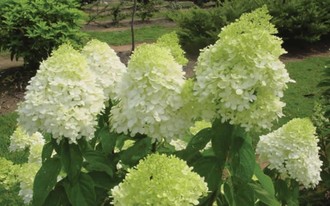 9.5 / 10 Rating Reviews Limelight is a very good panicle hydrangea. On a 2-year-old seedling there were very large inflorescences, the shoots do not droop and do not fall apart in rainy weather.
|
The best varieties of tree hydrangeas
|
Annabelle 440 (for a seedling 15-25 cm high with a closed root system) Delicate tree hydrangea variety. Shrub no more than 1.5 m in height and up to 3 m in diameter. The crown is spherical, loose. Spherical inflorescences with a diameter of 15 - 25 cm consist of sterile flowers. At the beginning of the dissolution, there is a greenish tint, and then they become snow-white. The leaves remain green for a very long time, turning slightly yellow in late autumn. Shows excellent frost resistance, is rarely affected by diseases, grows quickly and easily recovers. In one place, without transplanting, the bushes grow for 40-50 years or more, without losing their decorative effect. In the Middle Lane, young seedlings are covered. Main pluses:
Minuses:
|
 9.7 / 10 Rating Reviews My tree hydrangea Anabel adorns the collection of conifers, they complement each other well: a white fluffy hat and juicy greenery.
|
|
Sterilis 500 (for a seedling 20-30 cm high with a closed root system) A well-known tree hydrangea variety. Shrub 1.3 - 1.9 m high with a rounded crown. The foliage is medium, the bush looks loose. Young shoots are green, pubescent. Lush hemispherical inflorescences with a diameter of 20 - 30 cm consist of large sterile flowers. In complete dissolution, inflorescences are pure white. Winter hardiness is high (zones 4 - 5), but in regions with severe winters, shelter is required. Has a high growth rate and quickly grows shoots. For the formation of large inflorescences, it needs annual spring pruning. Main pluses:
Minuses:
|
 9.5 / 10 Rating Reviews I really like the huge caps of Sterilis hydrangea inflorescences, which are good when cut. I forgive him for drooping heads.
|
|
White Dome 440 (for a seedling 15-25 cm high with a closed root system) A variety of tree hydrangea. The bush is 1.2 - 1.5 m high, with a rounded crown. The leaves are large, up to 20 cm in length. Inflorescences are a flat shield, in the form of a dome with a diameter of 10 - 25 cm, in the center there are small fertile flowers, and large sterile flowers only along the edge, which gives the effect of openwork.The color of the inflorescences is creamy with a snow-white border. The shoots are strong, erect, the bush keeps its shape and without support. A spherical crown in diameter can reach 2 - 3 m. The growth force is high, the annual growth is 20 cm. Winter hardiness is high (zone 5). In the Leningrad Region and the Moscow Region, adult plants hibernate without shelter, but young ones can freeze slightly. Main pluses:
Minuses:
|
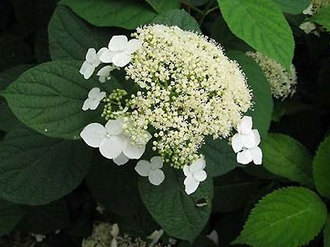 9.5 / 10 Rating Reviews Every winter I cut it into 2 buds, the bush winters well and blooms profusely. Compact and neat variety.
|
The best varieties of large-leaved hydrangeas
|
Endless Summer 500 (for a seedling 15 - 20 cm high with a closed root system) Legendary large-leaved hydrangea variety capable of blooming both on last year's shoots and on the current year's shoots. It belongs to the group of remontant varieties. This feature is important for Central Russia. Even in case of freezing, the bush in favorable conditions can please with flowering. Due to its ability to form buds several times per season, the variety was named "Endless Summer". In a sunny place, the bush does not grow higher than 1.5 m, but gives many spherical inflorescences with a diameter of 10 - 15 cm. The color of sterile flowers can vary from bright pink to blue, depending on the acidity of the soil. Often, the same plant contains inflorescences of different shades. Bright inflorescences are good for cutting, from which they form original bouquets with a delicate aroma. Despite the high declared frost resistance, in the Middle Lane it is recommended to mulch and cover the bushes with non-woven material. Main pluses:
Minuses:
|
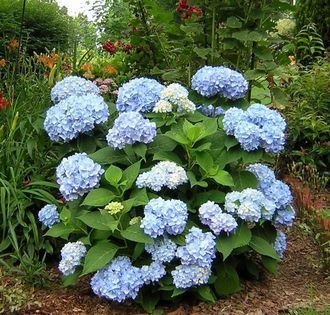 9.7 / 10 Rating Reviews The first 2 years I created the best conditions for the growth of a small hydrangea seedling, and now I enjoy a neat bush and lush flowering.
|
|
Peppermint 350 (for a seedling 15 - 20 cm high with a closed root system) Repairing variety of large-leaved hydrangea from the Forever & Ever series. The unusual two-tone color of the inflorescences attracts attention: the flowers have a wide white border, and in the center they can be pink, purple or blue. Inflorescences of large sterile flowers, up to 25 cm in diameter, in the form of a hemisphere. The height of the bush is 0.7 - 0.9 m, a compact spherical crown. Suitable for container growing. For full development, sunny areas are allocated, partial shade - only in the south. Main pluses:
Minuses:
|
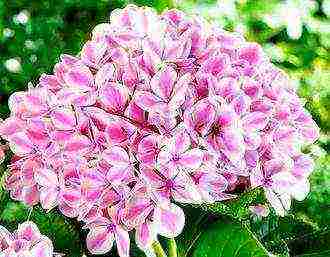 9.5 / 10 Rating Reviews The variety is good, but not for lazy growers. Requires proper treatment and a lot of attention. An adult bush hibernates under cover and blooms twice and is very abundant.
|
All hydrangeas love frequent and abundant watering. For planting, areas protected from the winds are chosen from the south or east side. In landscape design, hydrangea is used as a tapeworm on the lawn or in compositions with roses, clematis, lilies, spirea, rhododendrons, barberries, lilacs and conifers. When choosing neighbors, not only aesthetic compatibility is taken into account, but also general requirements for soil composition and care. Hydrangeas are equally apt to complement the garden in a natural, natural style and in a sophisticated Japanese style. Hedges from different varieties of the same species look spectacular.
Attention! The reliability of the information and the results of the ratings is subjective and does not constitute advertising.
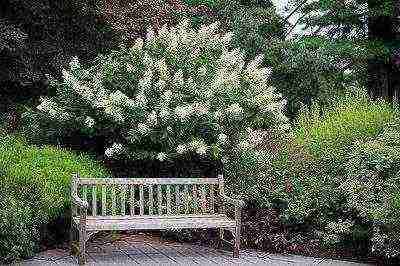 It happened in a distant year BC. A baby was born who was destined to become a great Buddha.
It happened in a distant year BC. A baby was born who was destined to become a great Buddha.
Instead of rain, sweet nectar poured down from the sky onto the earth, and unusually beautiful flowers fell.
The Japanese call them audzisai and believe that the wondrous plant brings good luck and protects the house from evil forces.
…
Description
A flower from a Japanese legend came to Europe in the middle of the 18th century and was named hydrangea.
Shrub or small tree from the family of saxifrage there are thirty-five species.
Palm most gardeners give panicle hydrangeas. There are several reasons for this.
- The plant is unpretentious... Grows well in ecologically unfavorable areas. She is not afraid of swampy and clayey soils. The shrub feels great in the shade and under the scorching rays of the sun. Adapted for cultivation in any region of the country.
- Increased frost resistance allows you to grow flowers in the conditions of the Russian north. Hydrangea does not need insulation. Some varieties can withstand temperatures up to - 35 degrees.
- Fast growth allows you to equip the landscape in a short time. Hydrangea is a durable plant.
- Planting and grooming does not take long and extensive knowledge of horticulture. Even an inexperienced grower can grow a hydrangea.
Hydrangea paniculata depending on the variety, there can be two types:
- Tall (two to five meters) shrub with elliptical or rounded leaves with serrated edges.
- Small (up to ten meters) tree with a very dense crown of oval, velvety leaves to the touch.
Leaves panicle hydrangeas are rather large, from 5 to 15 cm long. They are located opposite. The outer side of the leaf is colored in various shades of green. On the reverse side, the leaves can be pale green or grayish.
All varieties grown in the middle lane of the country are deciduous. The evergreen panicle hydrangea grows only in regions with warm climates.
Root system panicle hydrangea is powerful and wide. Its border extends far beyond the crown. The roots of the plant are thick, but shallow. This must be taken into account when landing.
Bush has one barrel... He does not give overgrowth around him. The branches are long and thin.
At their ends are formed pyramidal panicles (hence the name of the species). Dense large cones are collected from many flat flowers. Inflorescences cover the entire bush. They reach 35 cm in length and 20-25 cm in width.
Flowers panicle hydrangeas are unusual. Instead of petals, the hydrangea has sepals.
An important fruiting function is performed by small nondescript white flowers. They are located in the center of the inflorescence and fall off early. In their place, a fruit resembling a vessel appears. The seeds are very small. They have a high germination capacity.
Fruitless flowers are designed to attract insects and delight the eye with wondrous beauty. Large (up to seven centimeters in diameter), various shades, they bloom from June to late autumn.
Hydrangea flowers several times per season change color... And since the panicle hydrangea blooms for a very long time, on one bush you can often see flowers of different shades. The spectacle is mesmerizing.
You can change the color of hydrangea paniculata on one's own... Using aluminum alum, sulfur, iron salts, you can conduct fascinating experiments and achieve a variety of shades. The garden will be decorated with blue, purple and even two-colored panicles.
Next, let's talk about panicle hydrangea: photos and varieties.
Panicle hydrangea: varieties, photos
They differ in plant height, flowering time, color and size of inflorescences.
When choosing a variety, you should consider climatic features of the region in which it is planned to grow hydrangea. Frost-resistant "Bobo", "Great Star", "Kiushu", "Polar Bear" will feel good in any region.
Heat-loving "Limelight" or "Medical Moonlight" are suitable for the southern regions.
Consider the best varieties of panicle hydrangea (description with photo), as well as relatively new species.
Grandiflora popular with Russian gardeners. Differs in rapid growth. During the year, it adds up to 25 cm. The inflorescences are pyramidal, long and wide. It begins to bloom late.When blooming, the flowers have a delicate creamy color, in full bloom they become dazzling white. Under the autumn sun, they turn pink, then acquire a red-green color.
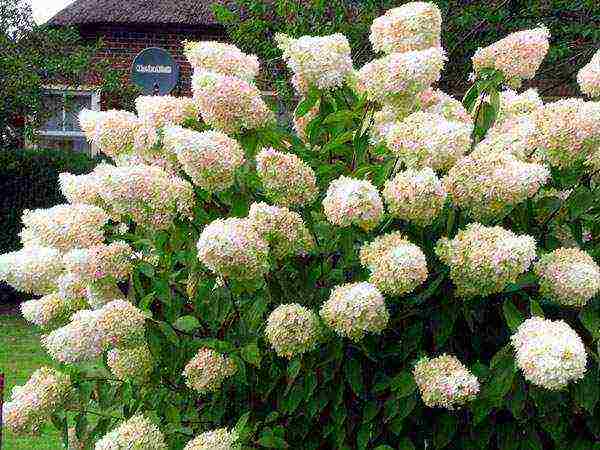
Kyushu - an elegant three-meter shrub with lush, smooth foliage. The inflorescences resemble arrowheads. The flowers are medium-sized, pale. The plant has a very pleasant delicate aroma and is a good honey plant.
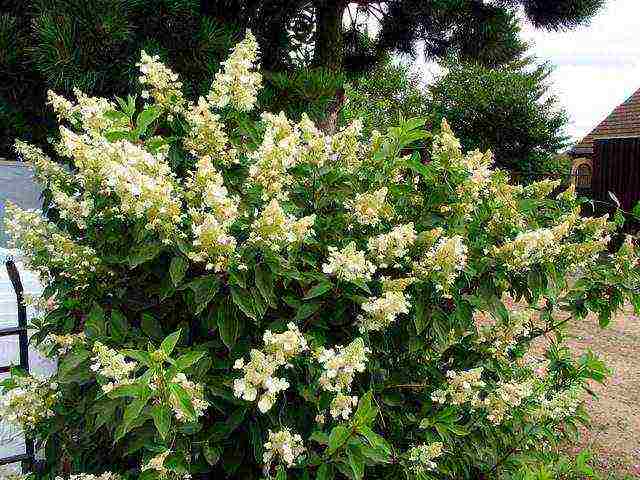
Limelight - a powerful shrub with large lush inflorescences. The initially greenish-yellow flowers take on a creamy white color over time. The plant is thermophilic. Loves the sun and open areas.
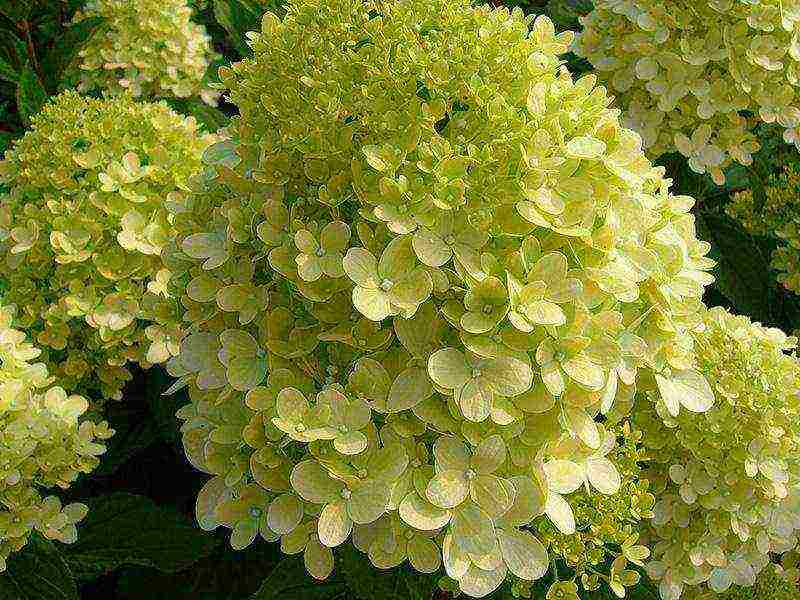
And here is a video about Limelight panicle hydrangea.
Tardiva appreciated for late unusual flowering. A deciduous, frost-hardy shrub with a rounded crown that can grow up to two meters. Greenish buds appear in mid-July. They bloom slowly. Hydrangea blooms profusely from late September to November frost. Inflorescences are thin, narrow, pyramidal in shape.
They consist of a large number of small fruiting flowers. Large sterile flowers are at first white or creamy, with time they acquire a pink tint. If the autumn days are sunny, the inflorescences turn red brick or purple. At the end of flowering, they turn green again.
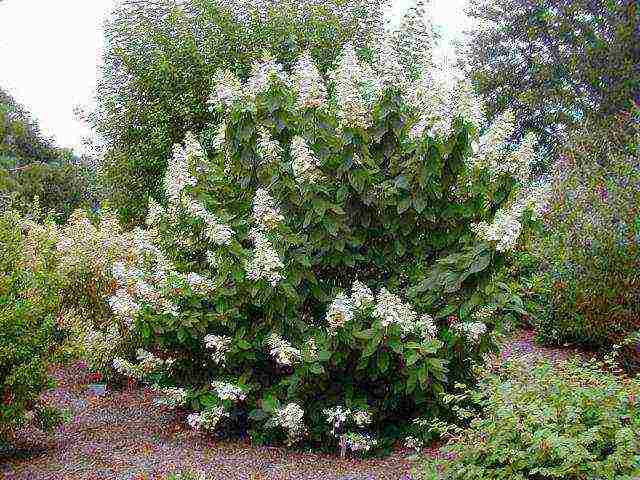
Bobo in 2011 he received an award at an exhibition in Belgium as the best new winter-hardy variety. He is not afraid of frost down to -34 degrees. It is considered a dwarf variety. The bush grows up to 70 cm. It blooms magnificently, but does not really like the sun. The inflorescences are conical. Changes in color from delicate lemon green to white and light pink.
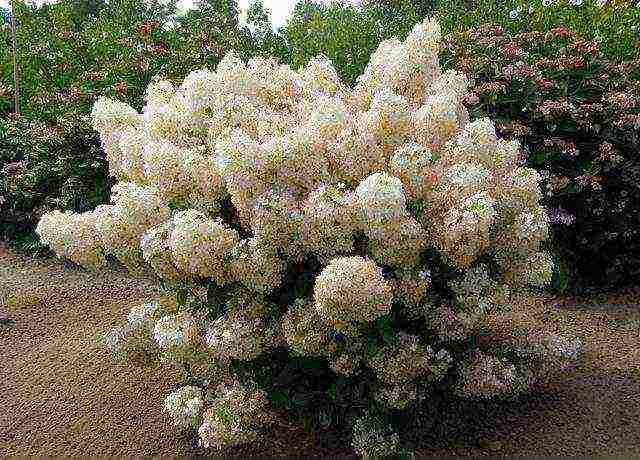
Precox are very fond of Japanese gardeners. It is gaining popularity in Russia as well. The earliest variety with a dense crown and rough leaves. Already in June will delight you with large white panicles
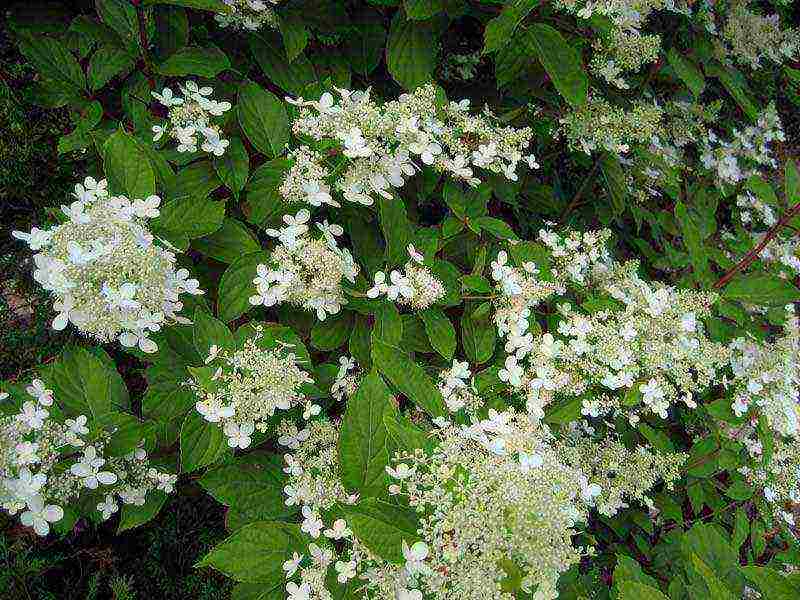
Vanilla Fries - a lush, spreading hydrangea with large pyramid-shaped inflorescences. It is considered a leader in sales. Late-flowering shrubs are not afraid of severe frosts. White flowers quickly take on a rich pink hue.
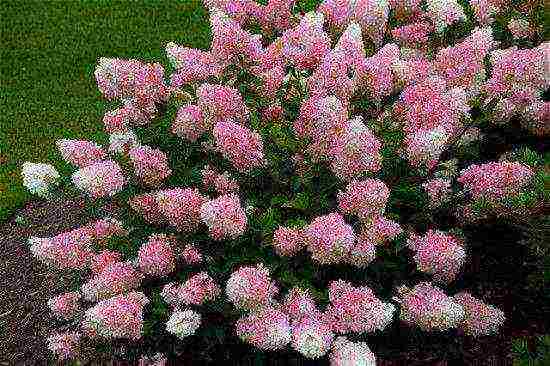
Medical Moonlight (Magic Moonlight) lives up to its name. Creamy white, greenish huge inflorescences do not change color in autumn. But they change their shape. Rounded at the beginning of flowering, they gradually elongate and by autumn they acquire a conical shape. Blooms profusely from late June to early September.
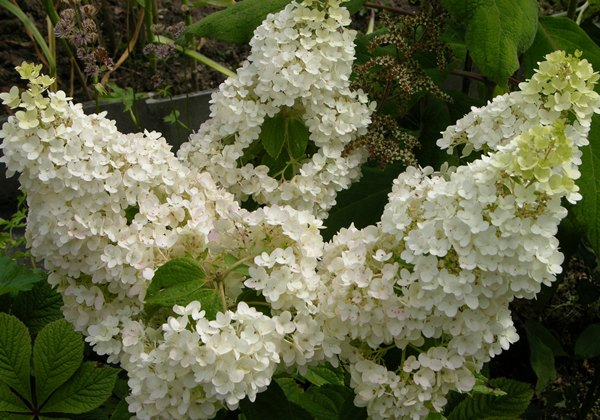
Great Star attracts flower growers with unusual flowers. To some, they resemble a propeller. Others compare them to snow-white butterflies. The flowers are large, with a diameter of 8 - 10 cm. One of the few varieties that do not change color throughout the entire flowering. The variety grows well in adverse conditions in industrial cities, but prefers shade. The variety is frost-resistant.
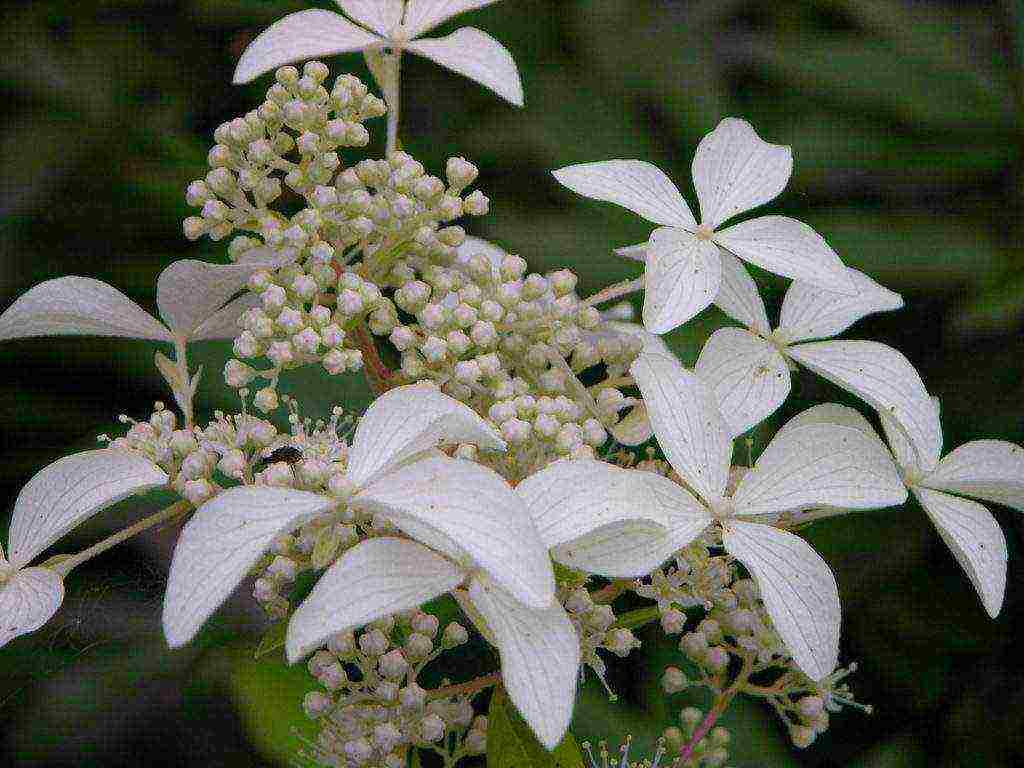
polar bear - a new variety. It appeared in 2013 and immediately gained popularity among gardeners. White flowers in huge inflorescences look very impressive. A frost-resistant variety with strong shoots grows well in regions with harsh climates.
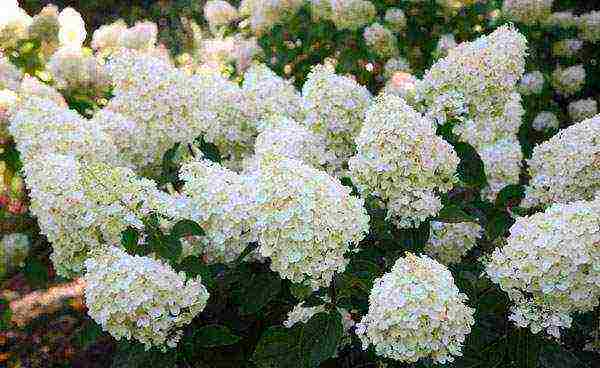
Diamond Rouge appreciated for its marvelous beauty and winter hardiness. Inflorescences are very large, up to 40 cm in diameter. White flowers gradually turn pink. A little later, they acquire a red hue, to which purple is added in the fall. Hydrangea of this variety blooms for a long time, therefore, flowers of different shades can be on the bush at the same time.
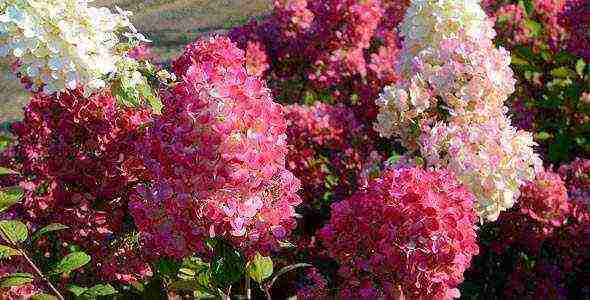
Fraz Melba - a wonderful novelty from last year. The flowers are sterile, so the inflorescences reach 40 cm in length. A dense cascade of milky-white flowers gradually changes shade from delicate pink to deep red. The bush reaches two meters in height and blooms until freezing.
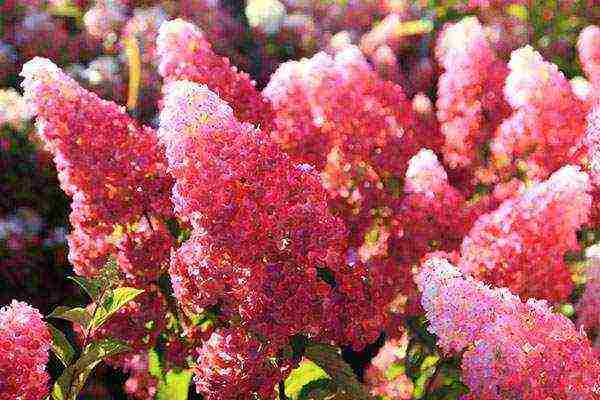
Variety of varieties panicle hydrangea, its unpretentiousness and ease of growing will satisfy both experienced and novice florists. To your attention a video about varieties of panicle hydrangea.
This video tells about varieties of panicle hydrangea.
Hydrangea paniculata - medicinal plant... It is recommended to drink tea made from dried flowers for colds and cardiovascular diseases. A decoction of the root has a diuretic effect. It is used for kidney and prostate diseases.
And in this video there is more information about the panicle hydrangea.
Hydrangea paniculata by right features prominently in garden decoration... Shrubs are rarely found, which, along with the simplicity of cultivation, are distinguished by excellent decorative qualities and the duration of flowering. If you still do not have this shrub on your site, you should definitely start it.
The most popular and beautiful varieties for the Moscow region
Grandiflora
The brightest representative of the variety. This is a magnificent shrub with huge cone-shaped inflorescences, white at the beginning of flowering, turning to gray-red by autumn.
It is a large representative of the species. The height and volume of the bush reaches 2-3 meters, the inflorescences are 30 centimeters or more. Grandiflora is highly resistant to diseases and pests.
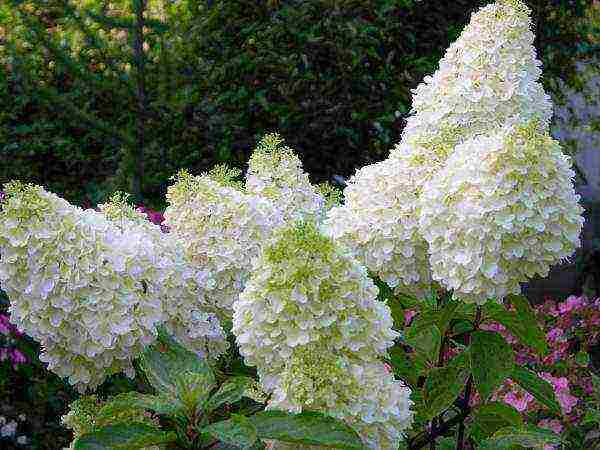 Variety of Grandiflora
Variety of Grandiflora
Bobo
Dwarf form. The maximum height of the Bobo variety is 1 meter, up to 80 centimeters in volume. It blooms from July to frost with pink, white, yellow flowers.
Grows well in partial shade. Needs regular watering and loosening of the soil under the bush.
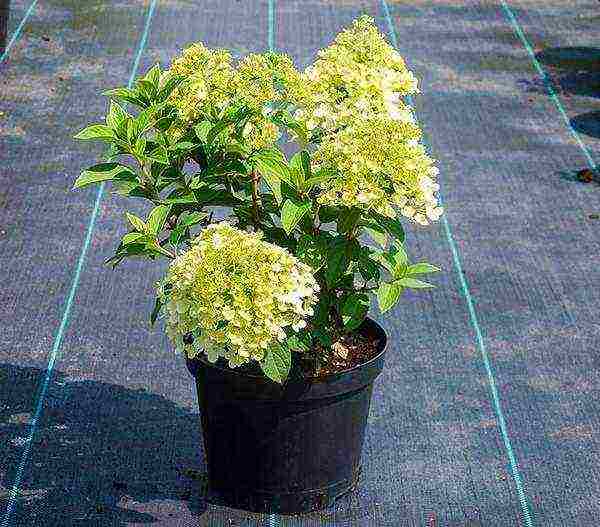 Bobo variety
Bobo variety
Vanilla Fries
The height of the bush is up to 3 meters. Abundant flowering with varying colors from white to pink, erect shoots, up to 40 cm long.
The bush calmly withstands even the very cold winter of the Moscow region without shelter. Prefers sunny areas protected from the wind. Variety Vanilla Fries has decorative leaves - dark green velvet.
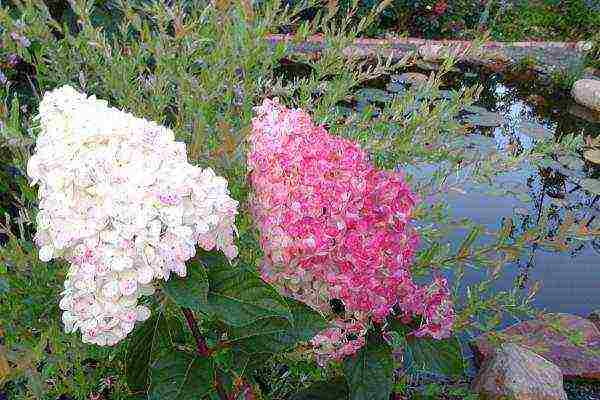 Vanilla Fries
Vanilla Fries
Anabel
It features a compact bush, one and a half meters high. Inflorescences are white, easily amenable to color change when irrigated with different fertilizers. You can make the Annabelle hydrangea bush bloom with several flowers at the same time.
This variety is long-lived; with good care, it can bloom for up to forty years in one place. There is a subspecies - Strong Anabel, which is distinguished by a longer and more abundant flowering.
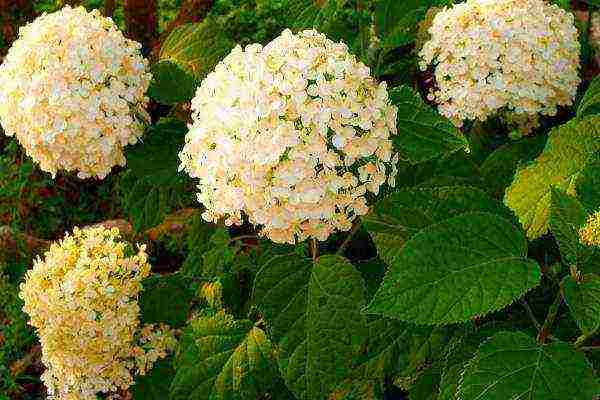 Anabel variety
Anabel variety
Phantom
Abundantly flowering shrub, due to the splendor of the flowers, the leaves of the plant are not visible. The height of the bush is up to 2.5 meters. It blooms with lilac or pink flowers, panicle length 30-35 cm.
The Phantom variety has a spreading crown, straight, powerful branches. The bush is good both in a single location and in group plantings. Requires mandatory pruning after flowering.
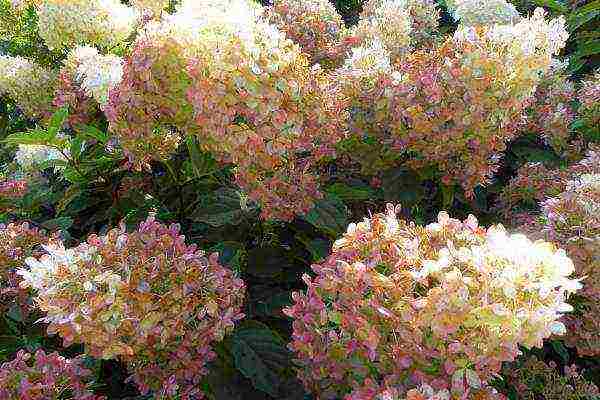 Phantom variety
Phantom variety
Limelight
A Dutch variety of panicle hydrangea with a rounded crown, decorative leaves, large, lush lime-colored inflorescences in summer, the color changes to pale pink in autumn.
The branches of the Limelight variety are strong, not sagging under the weight of the inflorescences, therefore the variety is often formed in the form of various geometric shapes (ball, cone, oval, etc.). The height of the bush reaches up to 1.5-2 meters.
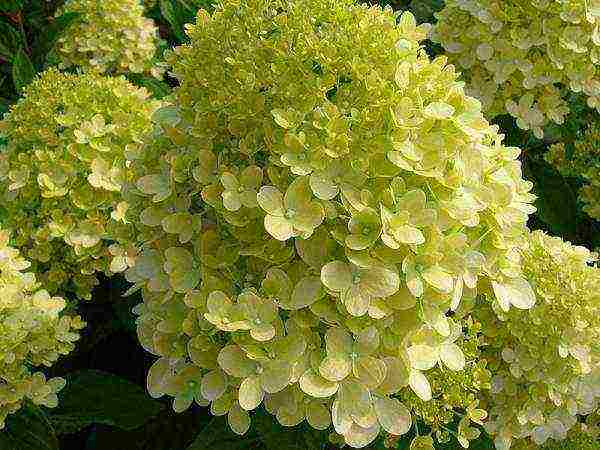 Limelight variety
Limelight variety
Pinky Winky
It is a shrub up to 2 meters high. A distinctive feature of the Pinky Winky variety is the rapid growth of the bush. In one season, it grows 30-40 cm.
Despite the large, up to 25 cm long inflorescences, it does not need support, it keeps its shape well. The variety is widely used in landscape design.
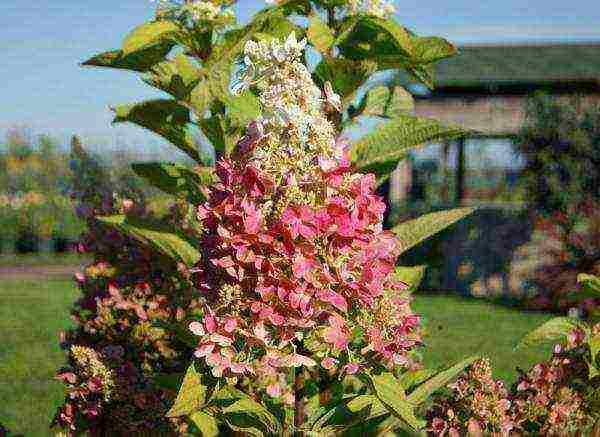 Pinky Winky variety
Pinky Winky variety
Daruma
Miniature shrub, maximum height 1.5 meters. Inflorescences from white and pale pink to dark red. Stems are red, decorative. Used for group landings.
The variety does not tolerate severe frosts; it needs shelter for the winter.
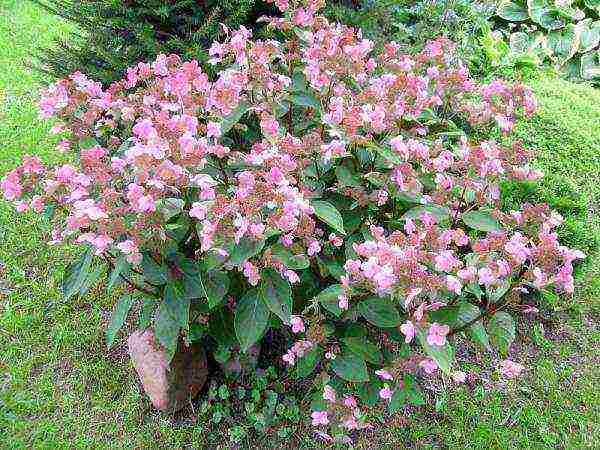 Daruma variety
Daruma variety
Weems Red
The new variety is a shrub up to 2 meters high. The inflorescences are large, the color changes over the season from pure white to bright burgundy.
Differs in a long flowering period (more than 4 months). Winters well without shelter.
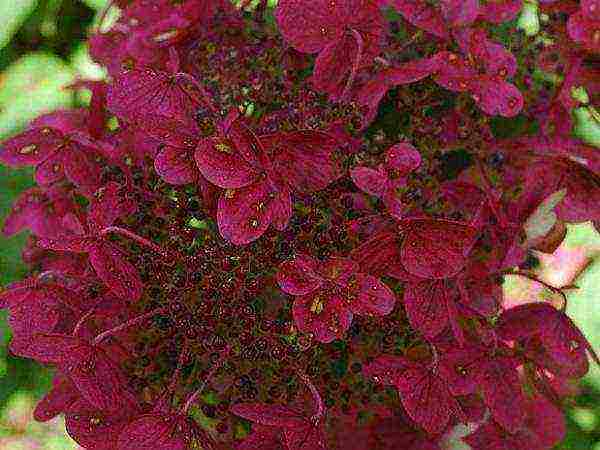 Weems Red variety
Weems Red variety
Description and characteristics, features of panicle hydrangea
This beautiful plant is called "a vessel of water" in Greek. It was brought from the island of Mauritius, which is located in the Indian Ocean in the eighteenth century.
Since then, the hydrangea has taken root well and spread throughout Europe and Asia. Her admirers were both palace gardens and flower gardens of ordinary citizens.
According to the description, panicle hydrangea is bush or tree in several trunks... Many gardeners shape it as a tree with one trunk. The height of the plant, if not cut, can reach more than 8-9 meters.
Oval plant leaves with a pointed tip. Their abundance guarantees a constant decorative appearance of the bush, even without flowers.
Flowering time from June to frost... It blooms in small inflorescences, collected in pyramidal panicles.
One of the features of flowering is the change in the color of the inflorescences. From white at the beginning of the season, the color of the panicles changes first to pink, and by autumn to gray-green.
An adult plant is frost-resistant, does not require shelter for the winter. Young bushes of the first and second years are best covered with spruce branches for the winter.
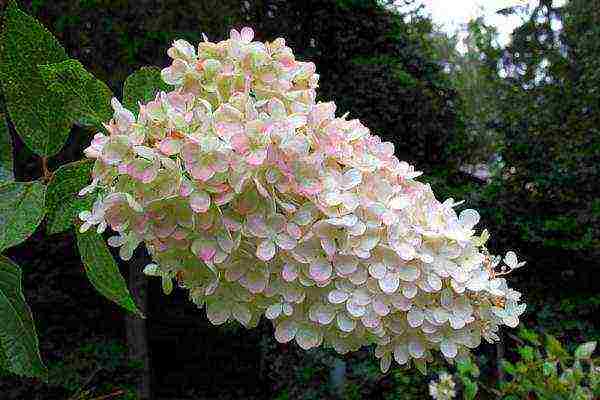 Hydrangea paniculata blooms from June to frost, frost-resistant
Hydrangea paniculata blooms from June to frost, frost-resistant
Planting tips
Shrub is planted in May or September... But if suddenly you have a seedling in the hot summer, do not despair.
Having planted it in fertile soil and protected from the sun, it will take root perfectly and will delight you with abundant flowering in 2-3 years.
Pick-up location choose light, but without direct sunlight. When planting on the south side, you will need to water the bush daily.
They are planted in a place protected from the winds, along walls or fences, if necessary, tied up.
It is necessary to plant in acidic, moist soil., better in clay or red earth. Peat and forest land are added to the planting pit. Top can be sprinkled with sawdust to retain moisture.
Due to the rather large size of the bush, the distance between plants should be at least 1.5 meters.
Interesting: experienced gardeners, to obtain a blue tint of flowers, add iron cans to the planting pit.
Planting panicle hydrangea in the ground:
Good care after planting
Care after planting consists in constant moistening of the root soil.
Do not allow the earthen coma under the plant to dry out, this will not only affect the decorative effect of the shrub, but can also lead to its death.
Hydrangea is better to overfill than underfill... Water the plant in hot weather daily, in damp weather, on demand.
Fertilizers
Hydrangea needs regular feeding... Top dressing is done once every two weeks.
She needs the presence of iron and ammonium sulfate in the soil. Therefore, nitrogen fertilizers are applied in spring and summer. Potassium salt in autumn.
The plant grows well with regular feeding with diluted mullein. In flower shops sell special complex fertilizers for hydrangeasthat contain all the necessary elements.
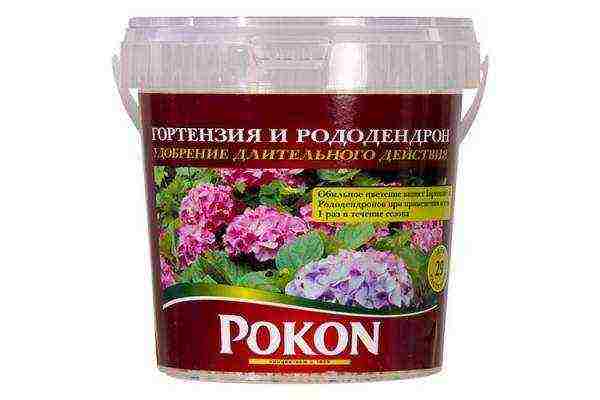 Hydrangea needs regular feeding once every two weeks.
Hydrangea needs regular feeding once every two weeks.
Shrub pruning
For lush flowering, the bush is pruned in the spring, at the beginning of April.... Last year's shoots are cut by a third, 1-3 pairs of buds are left on them, weak, dry branches are completely removed.
If the plant is not cut off, the flowering will not be abundant, the decorative effect of the bush will be lost.
Pruning hydrangeas in paniculate spring:
The use of pink, yellow and other hydrangeas in landscape design
The plant is widely used in landscape design to decorate flower beds, form a green fence, and a variety of flower ensembles.
It is combined with geraniums, ornamental grasses. Hydrangeas of different types, planted along the hedge, look very impressive.
Good to know: panicle hydrangea lends itself well to formative pruning, while maintaining a given appearance for a long time.It can be formed in the form of a tree, a ball, a cone, and other shapes.
The presence of Hydrangea paniculata in the garden will make the site beautiful, give the design a special chic and splendor.

